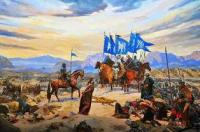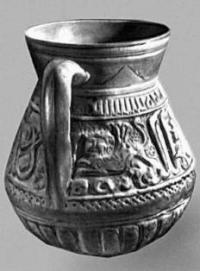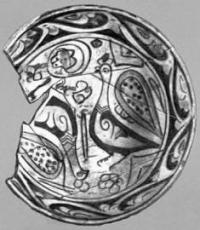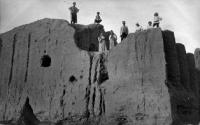You are here
Monuments of ancient Merv.





Excursions on monuments of Turkmenistan.
“Water is the life of the Turkmen
A horse is his wing; the rug, his soul”
Tours on monuments of Mary Region.
As you travel along The Great Silk Road you will often get to hear that the very highway or gravel road you are currently driving on, is indeed the very track that the Caravans of yore used to follow; even from an air conditioned sedan it does not take much to imagine the hardship of crossing the hot.
Arid steppes by camel and today's traveler is swept with the same feeling of relief and excitement as the caravans of times gone by when, quite abruptly, he crosses into one of the famous green oasis towns of Central Asia.
Those trade caravans would never have been able to survive the thousand- kilometer trek over loose sand dunes and stony hills stretching as far as the Caspian Sea, if it hadn't been for the lush oasis where both man and beast where able to regain their strength.
One such resting and trading place is ancient Merv, a cradle of one of the oldest civilizations on Earth. Merv on the territory of present day Turkmenistan was one of the major ancient cities of Central Asia, controlled by a succession of Iranian, Greek, Turkish and Central Asian rulers.
From her former glory, all that remains are fortification walls and tombs covering an area of almost 100 km2, a mere 30km drive from the modern-day city of Mary. From 1992 - 2000 nine archaeological expeditions were conducted as part of the International Merv.
Project [IMP]- a collaboration between the British Museum, University College London and the former Academy of Sciences of Turkmenistan. Settled since the III millenia, the best preserved remains of interest to the visitor are the fortress Erk-Kala and the Mausoleum of Sultan Sanjara.
In ancient times, Merv lay at the center of fertile lands about which numerous legends have been written. The Greek Historian Strabo wrote in the I century B.C. that in Merv he had seen grapevines so immense, their stalks as wide as two men put together. In the IV century B.C., Alexander the Great conquered the region, and the city became known as Alexander Margian.
After Alexander's death, his heir, Caesar Antioch I, ordered that the oasis be surrounded by a defense wall, the length of which was to be over 250km. Later, Iranian pagans further strengthened these walls with the aid of 10'000 captive Roman legionnaires, exiled there during the reign of Caesar Orod, after the armies of Marcus Linius Crassus defeated Orod in Asia.
Plutarch wrote: “The Romans were frightened by a thundering noise, then their enemy attacked, piercing the steel armor of the Romans warriors”. Indeed, the famous Damascene steel, able to cut through a silk scarf when dropped over it, was first invented in Merv.
During the Middle Ages, Merv was again seized, this time by Arab conquerors and in the XII century the city became the capital of the Seleucid Empire, a militant nomadic tribe of Turks who had arrived form the Northern Steppes, the ancestors of present-day Turkmen.
The most majestic monument of that time is the mausoleum of Sultan Sanjara, whose architecture best reflects the achievements of Islamic culture. Omar Khayyam, the remarkable poet of the Orient, lived and worked among the gardens of the Sanjara.
In 1221, Merv fell victim to the invasions of the Mongol Hordes of Genghis Khan. Legend has it that more than a million inhabitants perished, and the city was completely destroyed. Merv never again regained her former glory and in the VIII century, Merv became a part of the Russian Empire.
Modern-day Mary is accessible by road and air, you will find a place to stay, colorful bazaars, restaurants and chai khanas and factories or workshops producing the world-famous Turkmen carpets. There is a saying:
“Water is the life of the Turkmen; A horse is his wing; the rug, his soul.” Other things to do include guided camel rides among the fortification walls of Ancient Merv. A pick-nick not far away from Merv on the Bad Khyz plateau, where wild prickly pistachio trees grow, and wild herds of asses graze is equal fun.
For bird watching, try the banks along the Karakum canal, where in the thick reeds thousands of birds nest - white herons, storks, pelicans.
Authority:
http://www.discovery-central-asia.com







